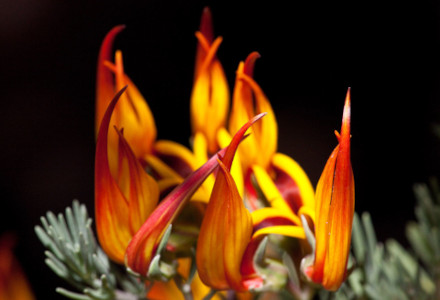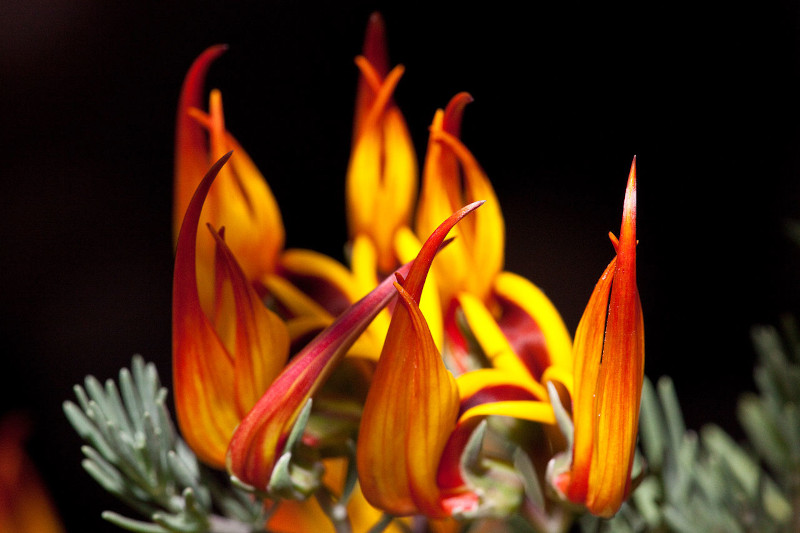Parrot’s Beak Facts
- This gorgeous product of Nature and evolution most frequently goes by the common name of the Parrot’s Beak. The visually unique plant has several others, however. These include such diverse terms as the pelican beak, the coral gem, and the lotus vine flower.
- Among scientific professionals, though, such as researchers, it’s usually referred to by its formal technical name. Fortunately, that’s relatively easy to pronounce, compared to many others, at least. That’s because it bears the formal name of the Lotus berthelotii.
- Regardless of which term one chooses to employ when speaking of it, the plant remains a remarkable species, as well as a member of the pea Family! The first formal recognition of it as a separate and distinct species, furthermore, occurred in 1881.
- The Parrot’s Beak appears to be nearly extinct in the wild. Despite this fact, though, the IUCN presently has no listing for it on the organization’s Red List. It’s an extremely popular ornamental species, though, providing some security from extinction.
- The surviving specimens in the wild, however, face severe threats to their existence. Habitat loss forms a real and present danger to them. The remaining wild specimens, though, likely face their greatest threat in the form of ongoing climate change.
Related Articles
Parrot’s Beak Physical Description
The beautiful Parrot’s Beak easily catches the eye with its beauty and distinctive appearance, of course. It accomplishes this, though, without the benefit of great size, as some species do. That’s because it generally spreads outward, instead of reaching upward, like many.
Officially, it qualifies as what’s known as an evergreen prostrate shrub. It’s also sometimes referred to as a subshrub, due to its low height. Most specimens, in fact, only attain a height measuring an average of 7.9 in (20 cm). It’s nevertheless an impressive variety of flora.
It typically spreads outward, along the ground, not climbing, unlike many related species. In point of fact, it manifests a strong, creeping or trailing tendency. In this it somewhat resembles a vine in nature. Its visual appeal doesn’t simply end here, however.
It also produces numerous leaves, typically divided into 3 – 5 leaflets. Each of these, in turn, usually grows to a length of about 0.4 – 0.8 in (1 – 2 cm), and has a width of around 0.04 in (1 mm). These further manifest a dense covering of small, silver-colored hairs.
It’s the flowers of the aptly-named Parrot’s Beak that serve as the source of its primary common name. These develop long and slender, averaging 0.8 – 1.6 in (2 -4 cm) in length, and about 0.2 – 0.3 in (5 – 8 mm) in width. Many think these resemble the beak of a parrot.
- Kingdom: Plantae
- Phylum: Tracheophytes
- Class: Angiosperms
- Order: Fabales
- Family: Fabaceae
- Genus: Lotus
- Species: L. berthelotii
Parrot’s Beak Distribution, Habitat, and Ecology
Sadly, its own range of natural distribution qualifies as one of the leading factors in its demise in the wild. That’s due to the fact that it appears to only be endemic to a very small section of the globe. That’s also a highly restrictive zone of habitation, given its nature.
That holds true due to the nature of where it evolved. This marvel of Nature exists in the wild, at least for the moment, only in a tiny portion of the Atlantic Ocean. More specifically, its native range appears to be limited to the what’s now known as the Canary Islands.
Presently, though, no evidence exists that it ever appeared beyond that range. Due to the nature of its evolutionary range, it understandably prefers a tropical climate. In that native range, the few specimens left appear to prefer open, strongly sunlit areas.
This species followed a slightly different path than some, in terms of pollination, however. That holds true due to the fact that insects do not appear to be its primary pollinators. Research indicates that it achieves the majority of its pollination via birds.
Previous research had indicated the likelihood that its main pollinators consisted of local species of sunbirds. Those, however, later became extinct. Subsequent study indicated that, in actuality, pollination occurs via the activities of random local avian species.
Visitation by such birds to the stunning Parrot’s Beak, though happen infrequently. The plant therefore evolved a unique adaptation. The blooms endure for a much greater span of time than most related species. This allows for increased chances of successful pollination.
Species Sharing Its Range
Check out our other articles on 3 Clearly Captivating Corals, Snowy Owl, Victoria Falls, Yellow Throated Marten, Reef Manta Ray, Saltwater Crocodile, New Zealand Giraffe Weevil


